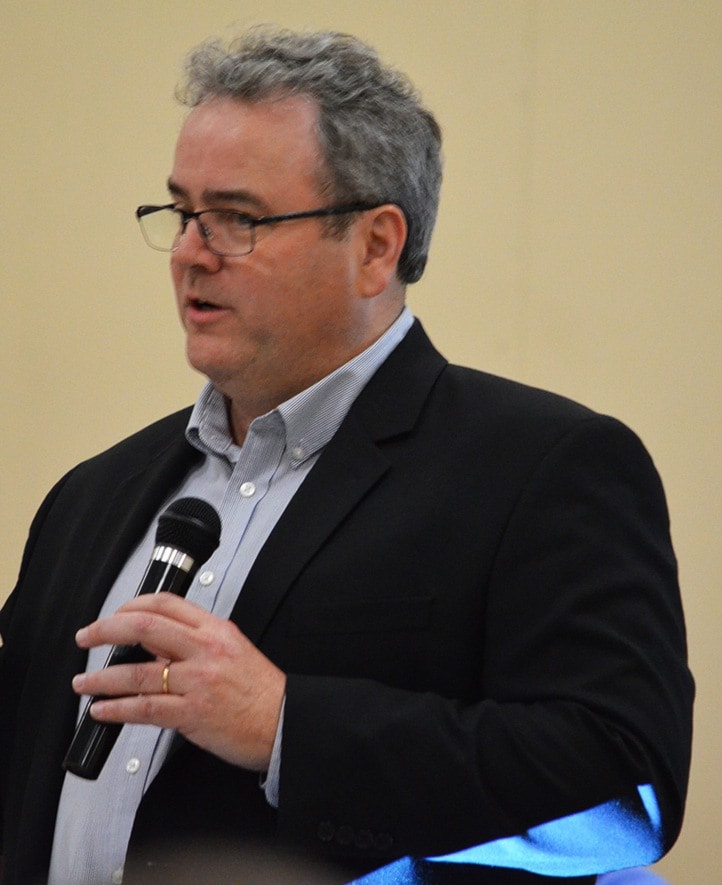The Ashcroft Community Hall was filled with local residents on Thursday, July 14 for a public information meeting about the water treatment plant project.
The moderator for the evening was John O’Fee, lawyer and former Kamloops city councillor, whose light-hearted but direct approach kept the meeting flowing nicely. Attendees heard from four presenters: Jessy Bhatti (Interior Health Authority); Peter Coxon (Urban Systems); Tyrone McCabe (Corix Utilities Inc.); and former Ashcroft mayor Andy Anderson.
Bhatti started off the presentations, and outlined legislation and guidelines from the Drinking Water Protection Act and Regulations, and the Water Sustainability Act and Regulations. He explained that any community water system must have a plan to meet treatment objectives. Because Ashcroft draws its water from the Thompson River, which is surface water, the village needs to have a system in place to treat viruses, protozoa, bacteria, and turbidity.
Coxon explained that in Ashcroft’s present water system the quality is good, but because of turbidity issues it does not meet provincial standards or federal guidelines for drinking water quality. The problem is that water cannot be disinfected properly with turbidity present. In order to filtrate and remove protozoa and viruses and deal with turbidity, the village needs a multiple approach to achieve what is required.
The different types of filtration systems were explained by McCabe. A sand filtration system is cheaper to install, but requires more operator attention/cost. A membrane filtration system is more expensive to install, but requires less operator attention, which translates into lower costs overall. The membrane system is the most robust system and produces the most consistent and superior water quality; it is also the most effective system.
Former mayor Anderson noted that Ashcroft had applied for, and received notice that it would receive, a $5.7 million grant for the water treatment system project. He noted that with a membrane system the turbidity in the water would be filtered out; thus hot water tanks and appliances would last longer, and residents would be able to drink water right out of the tap: no water coolers with filters would be required, nor would bottled water have to be purchased. The reservoirs would not have to be cleaned as often, also saving operational money for the village. And because turbidity would no longer be an issue, not as much chlorine would have to be used. (The more turbidity there is, the more chlorine that needs to be used to treat the water).
In addition to the $5.7 million grant, the village would need to borrow up to $4.1 million to complete the project. This will work out to $70 per residence per year. A resident asked what rate of interest would the village pay for the loan, and O’Fee replied that the village is able to borrow money through the B.C. Municipal Finance Authority, where the rates are better than what any bank could give them.
Another attendee asked what will happen if voters turn down the referendum. The reply was that because the village is not in compliance with either provincial or federal guidelines and regulations, IHA will write an order that the water treatment plant must be put into place (which is what happened in Kamloops.)
Attendees were presented with a choice. One was to agree to the referendum on the water treatment project loan, accept the grant money Ashcroft has received, pay $70 per year per residence, and end up with great water.
The other was to turn down the referendum, possibly lose the grant money, and end up paying for the whole project on the village’s dime, which would cost considerably more money.
In the question and answer period, one resident asked how many people used or bought bottled water, either by the bottle or by the jug. She noted that people are already paying more than $70 per year for this purchased water. With the new water treatment system, people will no longer need to purchase water; they will be able to drink it right out of the tap.
Another resident, new to town in the past five years, noted that a new water treatment system would do nothing but complement all the other positive things that are in Ashcroft, and said that the longer we wait the higher the price will be.
The information presented at the public meeting was to the point, factual, and indisputable. It made the point that it does not matter what Ashcroft has been doing for the past 40 years; this is now, and the village needs to upgrade what it has for the benefit of all.
